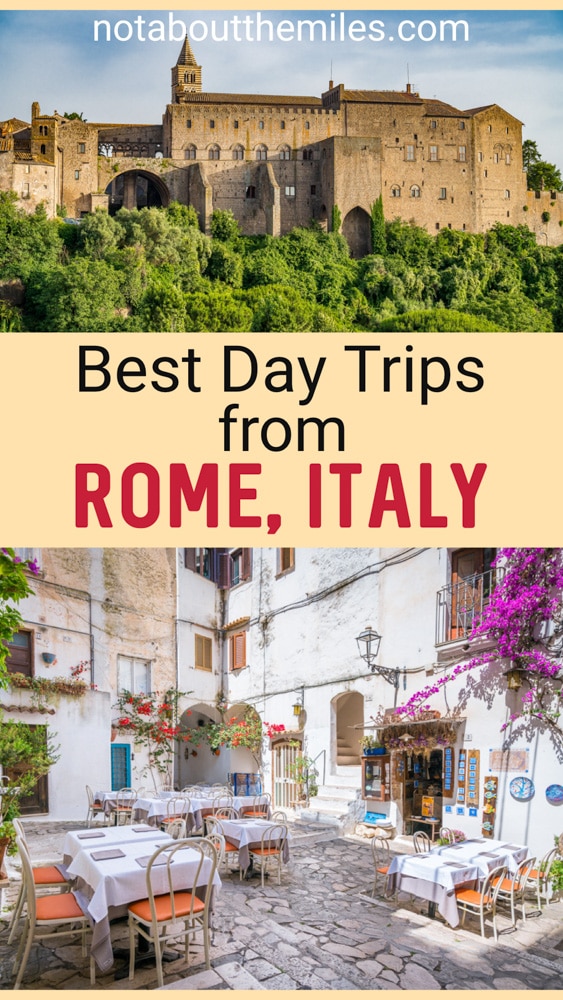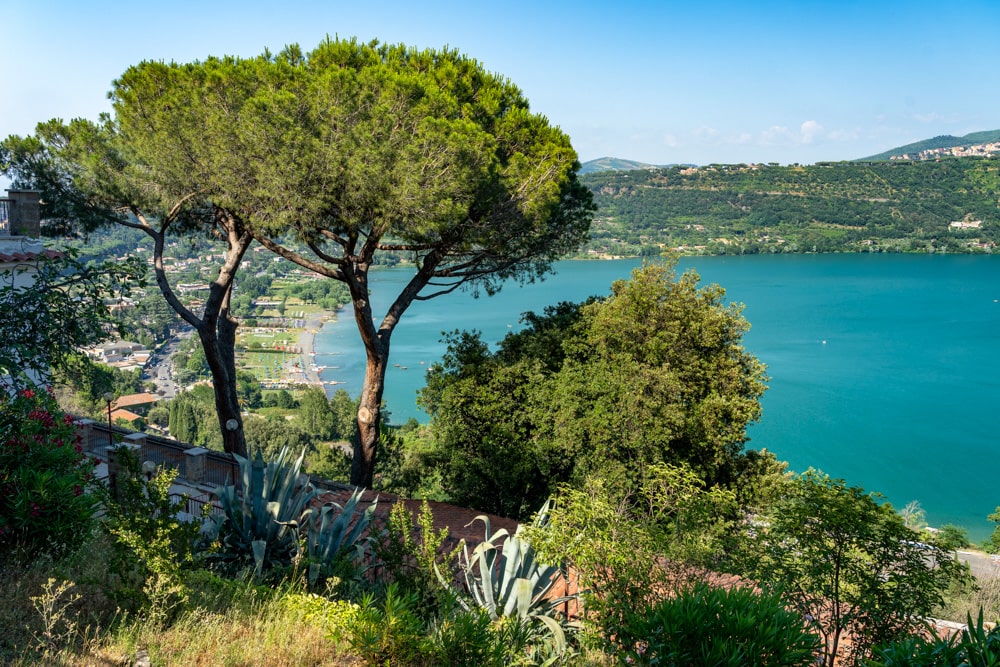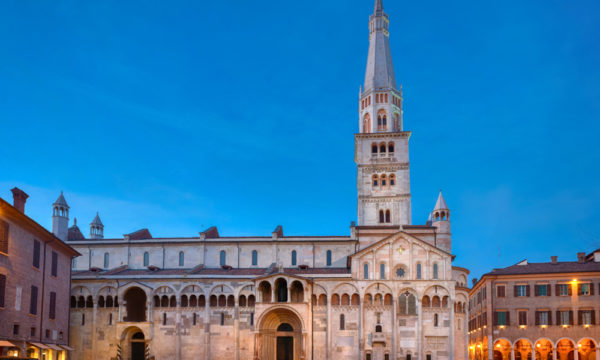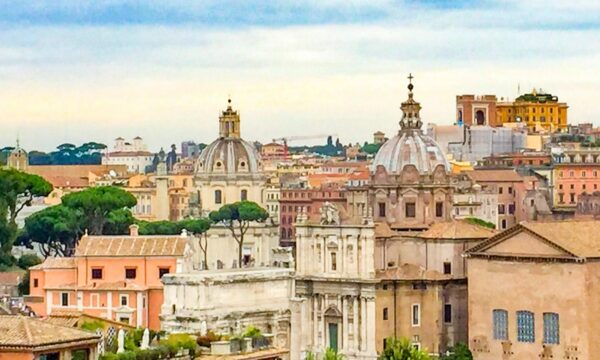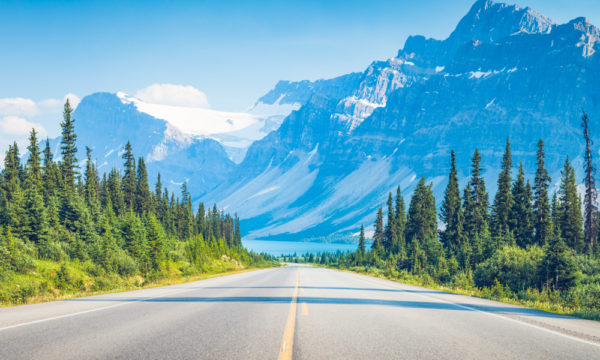There are so many wonderful things to do in Rome that you could spend weeks right in the city, savoring the history, landmarks, and food and drink. But leave room in your itinerary for a few day trips from Rome, to explore fascinating destinations around the Eternal City.
From ornate historic villas like the Villa d’Este to ancient necropolises like Cerveteri and charming hill towns like Orvieto and Assisi to other great Italian cities like Florence, you have lots of choices when it comes to day trips from Rome.
We’ve done a couple of day trips on each of our visits to Rome, but for this article we also invited colleagues in the travel blogging community to describe their favorite day trip from Rome.
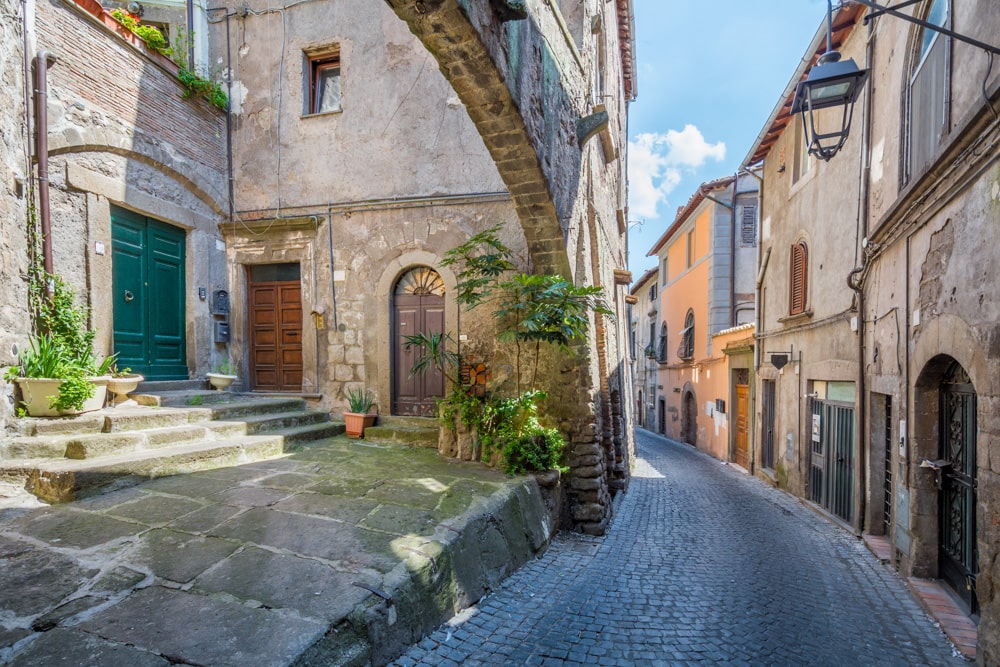
Some links on this page may be affiliate links. If you click an affiliate link and make a purchase, we may receive a small commission, at no extra cost to you. For more details, refer to our disclosure.
While a car definitely does add flexibility to your travel, most of the day trips from Rome we’ve described can be done using public transport, or if you prefer to leave the planning to someone else, on guided tours.
Any way you do them, these day trips from Rome will definitely add some excitement to your itinerary for Italy.
Ready to get started? Let’s discover the very best day trips from Rome!
TABLE OF CONTENTS
Day Trips from Rome 1 Hour or Under
Rome Day Trips between 1 and 2 Hours
Day Trips from Rome Over 2 Hours Away
Train Travel for Day Trips in Italy
Day Trips from Rome About 1 Hour or Under
Ostia Antica
The harbor city of ancient Rome, Ostia Antica is today a wonderful archaeological site you can visit. The site is remarkably well-preserved, and a must-visit if you enjoy history and ruins.
Located at the mouth of the tiber River, Ostia was coveted for its salt flats. Rome conquered it around 400 B.C., making Ostia its commercial port. Ostia was abandoned once Rome fell, and gradually silted up until the site was excavated.
Ostia’s magnificent theater, built in the first century B.C., is still used for concerts! The brick structure features marble seating for VIPs near the stage and orchestra stand.
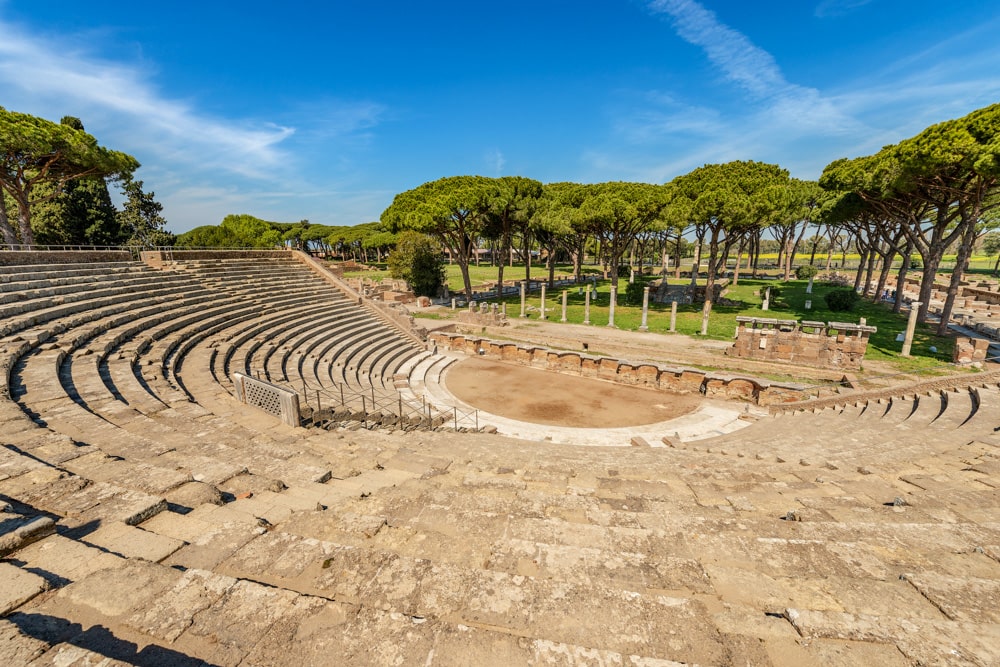
In front of the theater, the Square of the Guilds is what’s left of a bustling trading area. Mosaics hint at the goods and services offered by the many merchants that had their businesses along the square.
The Baths of Neptune feature beautiful black-and-white tiled pavement. Don’t miss the beautiful mosaic of Neptune riding four horses, best viewed from a viewpoint overlooking the baths.
Borgo di Ostia Antica is the tiny village around what used to be the Castle of Julius II. It’s a lovely area to stroll and snap photos, and there are several restaurants here if you want to have a meal after your exploration of the ruins.
While you can visit Ostia Antica any time of the year, spring and fall are ideal from a weather perspective. Bring sun protection, since much of the site is exposed.
The archaeological park is closed Mondays. Ostia Antica is a large site, so come wearing comfortable shoes so that you can wander about the ruins, explore, and take photos.
Getting to Ostia Antica from Rome
The train is an easy and convenient way to get to Ostia Antica. Take the train from the Roma Ostiense station. The journey time is about 30 minutes, and there are frequent departures in both directions.
In Ostia Antica, the train station is a very short walk from the archaeological site.
If you’re short on time, or you love the structure of a guided tour, consider this highly rated half-day tour of ancient Ostia from Rome! The small-group tour by train offers a guided tour through the ruins for an enhanced experience.
After the tour, you can return to Rome with the guide, or, if you do have the time, you can explore modern Ostia or visit the beach on your own and return afterwards by train.
Check pricing and availability for this Ostia Antica tour now!
Suggested by us
Hadrian’s Villa in Tivoli
Hadrian’s Villa, also known as Villa Adriana, is a UNESCO World Heritage Site in Tivoli, and makes for an ideal day trip from Rome, either alone or in conjunction with Villa d’Este.
Built as a retreat for Roman Emperor Hadrian in the early part of the second century A.D. the “villa” is actually a large complex of buildings, with palaces, temples, pools, baths, and more.
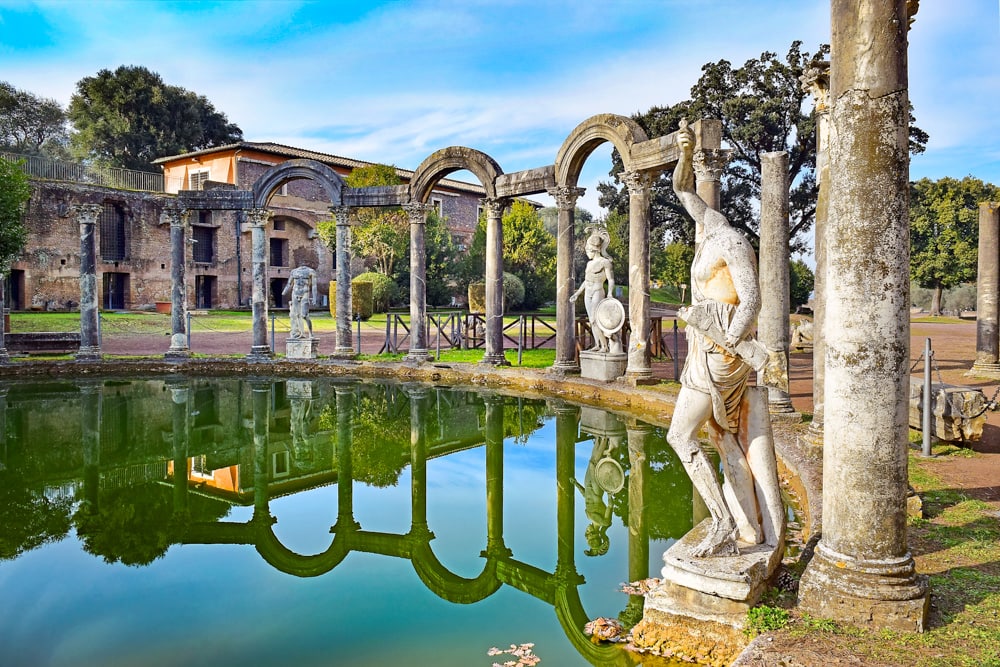
During the later years of his reign, Hadrian actually ruled the empire from his villa in Tivoli, and many of the buildings here actually offices and housing for officials in his administration.
Hadrian’s Villa is in ruins today, but wandering the site, you can imagine how the opulent complex must have looked in its heyday. Many of the statues and much of the marble was moved to decorate the Villa d’ Este, but some pieces still remain.
The complex contains about 30 buildings, spread over 250 acres, and incorporates multiple architectural styles. It’s an area larger than Pompeii.
The Canopus, the recreation area in the complex, features a long reflecting pool, said to represent the River Nile. The Maritime Theatre, the Three Exedras, the Temple of Venus, and the Piazza d’Oro are other notable sites in the complex.
Hadrian’s Villa is open at 9 a.m. everyday except Christmas and New Year’s, but closing hours vary between 5 p.m. and 7.30 p.m., based on time of year. General adult admission is usually 8 euros, but can be more when special exhibitions are offered.
Getting to Hadrian’s Villa from Rome
Hadrian’s Villa is located a couple of miles from the town of Tivoli. The easiest way to get there by public transport is to take the Metro Line B to Ponte Mammolo, and then the bus going to Via Prenestina, which will drop you about 0.2 mile from the villa.
Alternatively, you can take the train from Rome Tiburtina Station to Tivoli, and then the CAT bus Linea 4 from the town to Hadrian’s Villa.
If you plan to visit Villa d’Este as well, there is a bus that connects the two sites.
Want to visit on a guided tour? This popular full-day tour combines a visit to Hadrian’s Villa with a visit to the Villa d’Este for a memorable day trip from Rome. Enjoy expert commentary at both historic sites, and lunch on your own in the delightful little town of Tivoli.
Suggested by us
Villa d’Este in Tivoli
The Villa d’Este is a 16th century villa in Tivoli. It is regarded as an important symbol of the Italian Renaissance, and is designated a UNESCO World Heritage Site. Alone, or in combination with the Villa Adriana, Villa d’Este makes for a fabulous day trip from Rome.
Renowned for its spectacular terraced gardens featuring numerous fountains and water features, the Villa d’Este was built for Cardinal Ippolito d’Este, one of the sons of Lucrezia Borgia and a one-time governor of Tivoli.
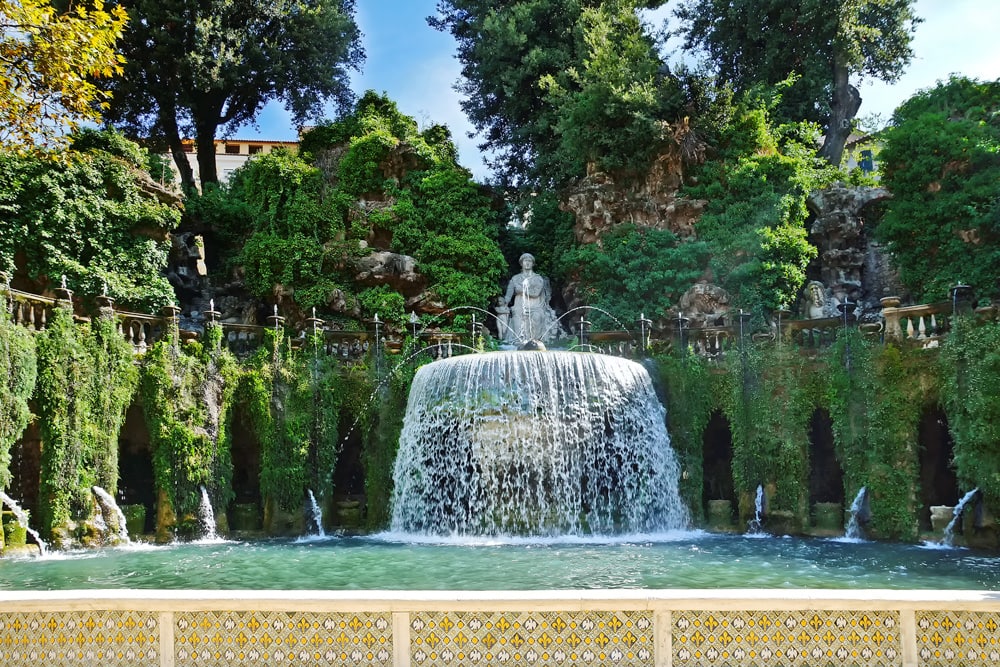
The complex, which includes the Palazzo d’Este and the gardens, covers close to 10 acres. The gardens are the highlight, and it is a joy to stroll and see the different types of fountains, which work with gravity: ingenious!
The palazzo contains art works and frescoes in a series of beautifully-decorated rooms, and the views from the terrace are lovely, but it is the gardens that will leave a lasting impression, so allow plenty of time to tour them.
The Oval Fountain, one of the first fountains in the garden, was designed as a water theater, with water spraying in many different forms. The Hundred Fountains is a long stunning gallery of water features.
The Fountain of the Organ will take your breath away, with its majestic water castle. It actually makes music, today playing four pieces of music after a restoration project in the early 2000s.
The Fountain of Neptune is new, created in the 20th century to replace a rock waterfall created in the 17th century by Bernini. Over time, it was neglected and wore away, requiring replacement.
The Villa d’Este is generally closed Mondays. On other days of the week, it opens at 8.30 a.m. Closing time varies based on time of year. General adult admission is usually 8 euros, but can be more when special exhibitions are offered.
Getting to the Villa d’Este in Tivoli from Rome
Take a direct train to Tivoli station from Roma Termini or Tiburtina. From the train station in Tivoli, the Villa d’Este is a short walk.
You can also catch the Metro Line B to Ponte Mammolo, and then the bus to Tivoli, which will drop you off near the entrance to the villa. If you plan to visit Villa Adriana as well, there is a bus that connects the two sites.
Visit by guided tour to learn a lot as you walk the historic sites: this highly-rated tour includes both the Villa d’Este and Villa Adriana for a full day out from Rome. You’ll travel by air-conditioned coach, and have free time in Tivoli to stroll and have lunch.
Suggested by us
Orvieto
The charming Umbrian hill town of Orvieto is one of the best day trips from Rome you can do. Orvieto is the perfect size for exploring in a day, and it is a beautiful town!
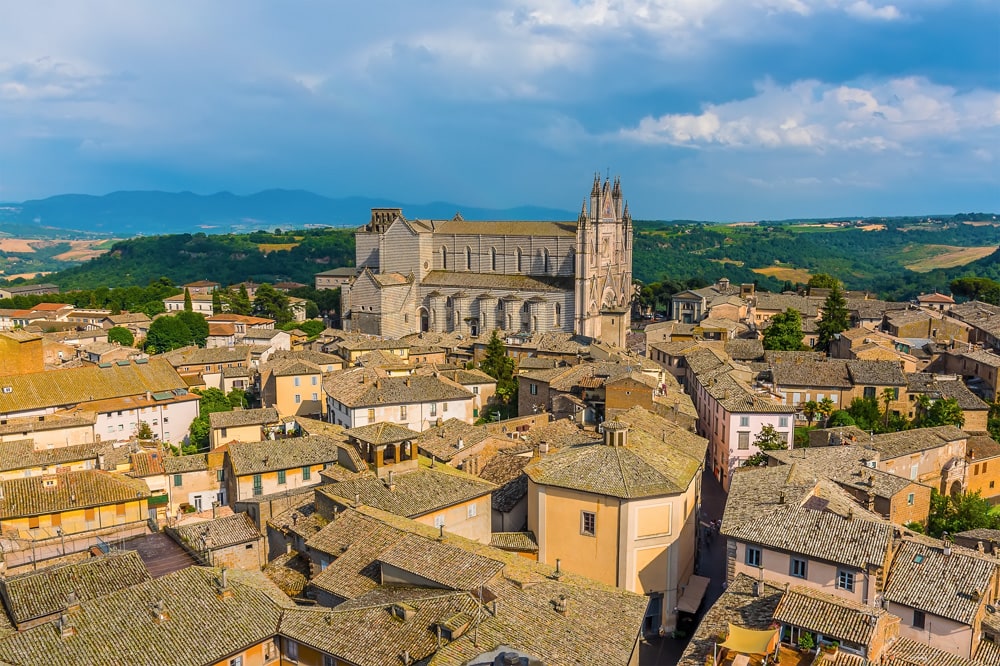
Start with a visit to Orvieto’s duomo, astonishingly ornate for a town of Orvieto’s size.
Gawk at the gleaming intricate facade that includes a large rose window, gorgeous bronze doors, and mosaics and bas reliefs for decoration.
Then step inside to tour the equally ornate interior, where you will find Luca Signorelli’s Chapel of the Madonna di San Brizio. Fra Angelico originally began decorating the chapel but stopped when summoned by the pope to work on another project.
Another must-visit site in Orvieto is the Pozzo di San Patrizio, a historic well that’s considered a civil engineering marvel. The shaft is encircled by two ramps in a double helix so that mules could carry empty and full water vessels without bumping into oncoming traffic.
Wandering the town is a joy. The streets are narrow and picturesque, with many shops to browse: Orvieto is famous for its ceramics. You’ll be stopping every few minutes to snap photos.
Climb up to the top of the Torre del Moro for views over the rooftops of Orvieto and the beautiful surrounding countryside. Take an underground tour of the Etruscan caves beneath the current town.
Near the funicular station, pause to take in the views of the surrounding countryside far below from the old fortress. The town of Orvieto is built on a volcanic tufa, and offers wonderful expansive views.
Getting to Orvieto from Rome
You can drive to Orvieto if you have a car. If you wish to use public transport, take the train, which takes about one hour. There are several departures in both directions everyday.
At Orvieto, take the funicular from the train station to get up the hill to the town. Once at the top, you can either take the local bus to the Piazza Duomo, or walk.
This well-reviewed full-day tour from Rome combines Orvieto and Assisi for an efficient way to visit two beautiful Umbrian hill towns. The tour includes lunch plus a tasting of local wines and local food products.
Book this tour now!
Suggested by us
Bracciano
Bracciano is one of the most beautiful and easy to access destinations for a day trip from Rome.
A must see because of its majestic castle on top of a hill, Bracciano also has a beautiful lakeshore with volcanic black sand.
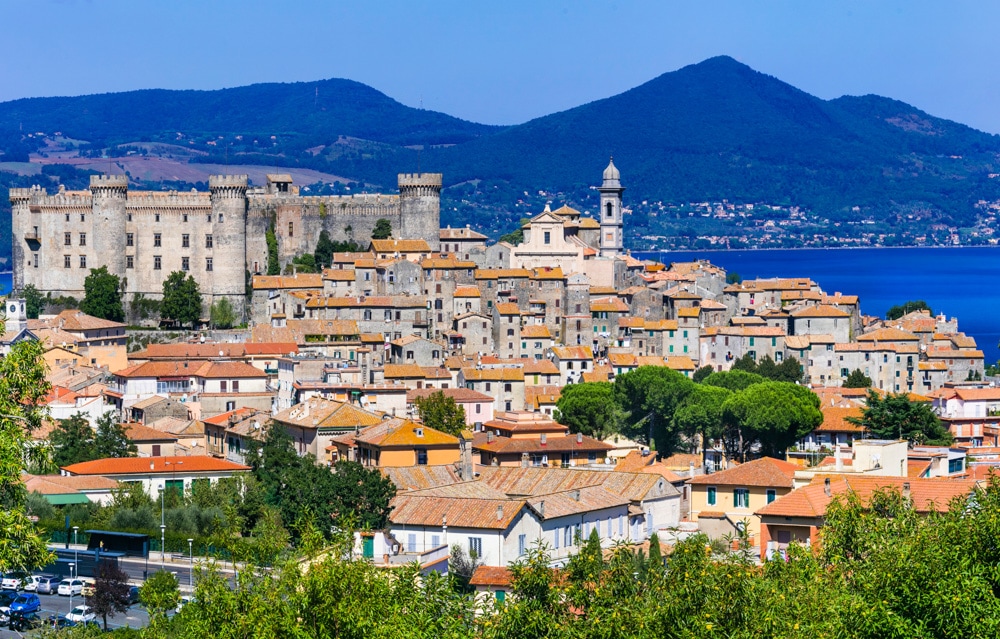
One of the best things to do in Bracciano is to visit the Orsini-Odescalchi Castle, which dominates the skyline of the town. Built in the 15th century, the castle was home to the Orsini and Borgia papal families.
Around the castle you will find the old village of Bracciano, with narrow streets, stone houses, and many, many flowers. There are a few viewpoints that offer panoramic views over the lake and the village itself.
Another great thing to do in Bracciano is sunbathe on the beach. Getting there requires going down a very steep path, or taking the local minibus, which connects the beach with the town during the high season.
The sand is black and the water is safe for swimming. There are also pedalo boats which you can hire if you want to explore more of the lake.
For a beautiful experience, have lunch at one of the restaurants overlooking the castle. Most of them serve typical Roman dishes such as pasta cacio e pepe or carbonara, as well as freshly grilled fish, from the lake.
The best time to visit Bracciano is in summer, when the weather is good enough to sunbathe. In winter, the beach is empty and has no facilities.
Getting to Bracciano from Rome
Bracciano is located about one hour away by regional train, taken from either Via Aurelia, Roma San Pietro, or Roma Tiburtina stations. The fastest time is from Via Aurelia, which is connected with the metro line.
Suggested by Joanna of The World in My Pocket
Castel Gandolfo
Easy to access from Rome, Castel Gandolfo is one of the best destinations for a day trip from the Eternal City. The little town is part of the Castelli Romani, a group of towns in the Colli Albani southeast of the city.
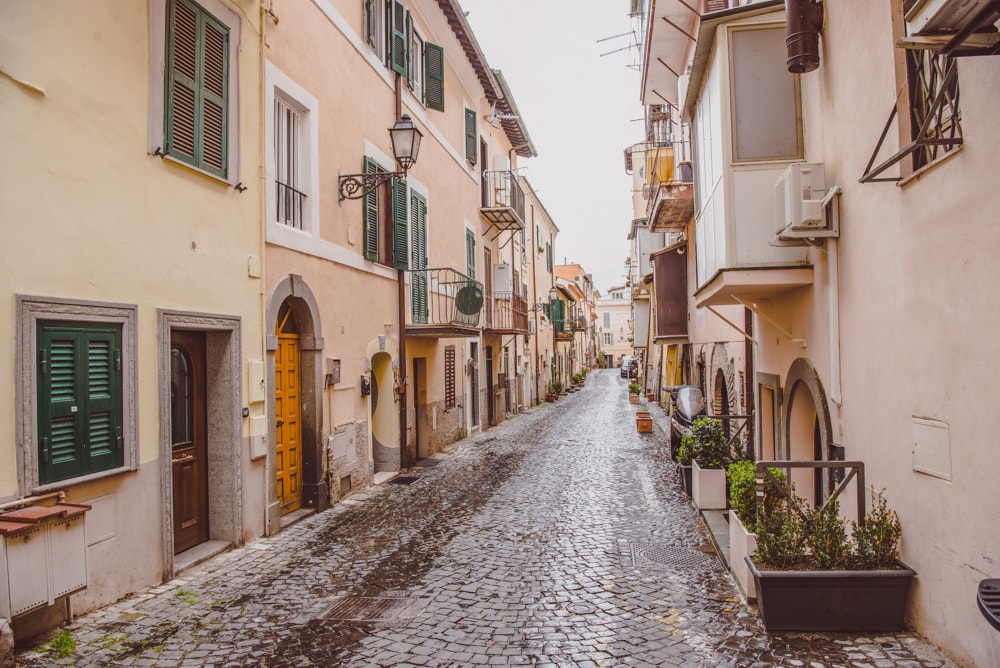
Located on the shore of Lago Albano, Castel Gandolfo is home to the pope’s summer residence. Touring the Pontifical Villas and Papal Palace is the top thing to do in the town.
The papal apartments are beautifully furnished are representative of the pageantry of the papacy. The views over the green-blue lake are fabulous. In the courtyard, you can see the various vehicles that historically transported the pope.
The manicured Barberini Gardens, built into the ruins of Emperor Domitian’s villa, are magnificent, with fountains, terraces, and a variety of plantings. You’ll tour the gardens in an open minibus. The grounds include a working farm, and vineyards.
This combined ticket is a convenient way to visit both the papal palace and the gardens. The tour comes with an audio guide, and includes the opportunity to lunch in the gardens.
The centro storico of Castel Gandolfo is charming and well worth a wander. The Chiesa di San Tommaso da Villanova is a small church with a modest facade, but inside it is beautiful. The church was designed by Gian Lorenzo Bernini.
Browse the small shops and have a coffee at one of the cafes on the Piazza Liberta, an excellent place for people-watching. Ristorante Gardenia, with views of the lake, is a great place to have lunch.
Getting to Castel Gandolfo from Rome
Take the train from Roma Termini to Castel Gandolfo. The journey is about 45 minutes each way. Make sure you buy a return ticket, as you may not be able to buy a ticket at Castel Gandolfo.
Note that you have to walk fairly steeply uphill on a cobbled street from the station to the town center of Castel Gandolfo. It’s about a 10-minute walk.
Suggested by us
The Etruscan Necropolis of Cerveteri
About 31 miles northwest of Rome and a few miles from the coast of the Tyrrhenian Sea you will find the largest Necropolis in the Mediterranean.
The Etruscan Necropolis of Cerveteri has been on the UNESCO list of World Heritage Sites since 2004. What makes it so much more attractive than many other Etruscan necropolises in central Italy is its aspect of a real monumental city of the dead.
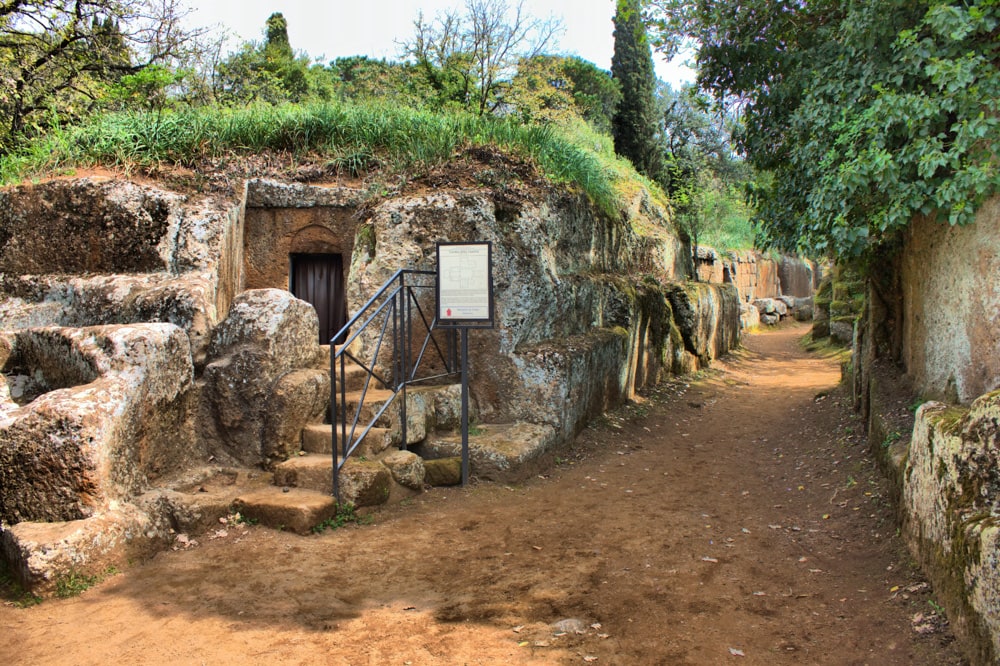
The Etruscans, from the civilization that flourished in Italy between the 10th and 3rd centuries B.C., believed deeply in life after death.
Researchers divide the necropolis of Cerveteri into three parts:
The area of the large mounds, which features monumental tombs that look like small hills.
The area of the fence, for which an entrance fee of €6 is charged. This is the best-preserved part, with about 2,000 tombs including those of the most important families: beds, pillows, seats, and columns are carved in the tufa stone.
The Way of the Underworld is a long and narrow path carved into the rock, with hundreds of tombs on several levels on both sides. Here you can take one of the most fascinating hikes near Rome, reaching what remains of the walls of the ancient Etruscan acropolis.
The best seasons to visit are spring and autumn.
Getting to Cerveteri from Rome
To get there, take a Trenitalia train to Marina di Cerveteri. Then take the local bus “Linea D” to the historic center of Cerveteri, and then walk about a mile, or get on the bus “Linea G,” to arrive at the Etruscan Necropolis.
You can also take Metro Line A in Rome to the Cornelia stop from where you can catch a CoTral bus to Cerveteri. The journey takes about an hour. Once you arrive it’s a 1.25-mile walk to the necropolis: follow signs.
Suggested by Lisa of Travel Connect Experience
Day Trips from Rome Between 1 and 2 Hours
Florence
As the capital of Tuscany and home of the Renaissance, of course Florence deserves far more than a day to explore–but if a day is all you have to work with, you can have a magnificent day trip from Rome to Florence!
Among the best things to do on a day trip to the Cradle of the Renaissance is visiting Florence’s iconic Duomo. Consider planning ahead to climb the cupola, and be sure to save time to visit the baptistery.
Booking a tour that includes the cupola is an efficient way to tour the Duomo complex and take in the views from the top. This highly-rated tour takes about 2 hours and includes the cathedral, baptistery, museum, and bell tower, along with the cupola climb.
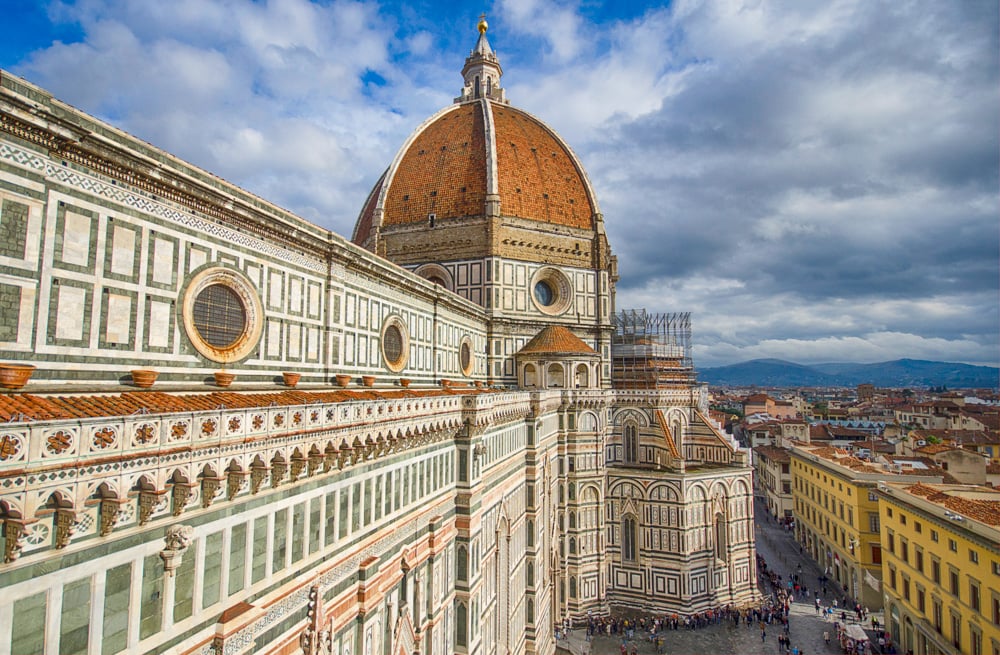
Admiring the views from Piazzale Michelangelo is also easy and delightful, and a fun way to get a view of the Florence skyline for free.
Visiting Michelangelo’s David in the Galleria dell’Accademia is another fantastic option, and the small museum is easy to see, even with only a day in Florence.
Half the fun of Florence is also simply soaking up its atmosphere in beautiful places like the Piazza della Signoria and the Piazza della Repubblica, as well as strolling across the Ponte Vecchio.
Pop into the Mercato Centrale to sample Tuscan delicacies and to have a quick lunch, and leave room for gelato!
Getting to Florence from Rome
The best way (and really only realistic way) to take a day trip to Florence from Rome is via the high-speed train, which takes about 1.5 hours each way.
Be sure to book your train tickets in advance, as prices increase as you get closer to your travel date!
Suggested by Kate of Our Escape Clause
Naples
If you’re looking for an easy day trip from Rome that showcases a part of Italy few tourists frequent, it is Naples, the City of the Sun.
Naples is often described as “gritty” and “authentic”, and both descriptions are accurate, but incomplete, portrayals of Italy’s third largest city.
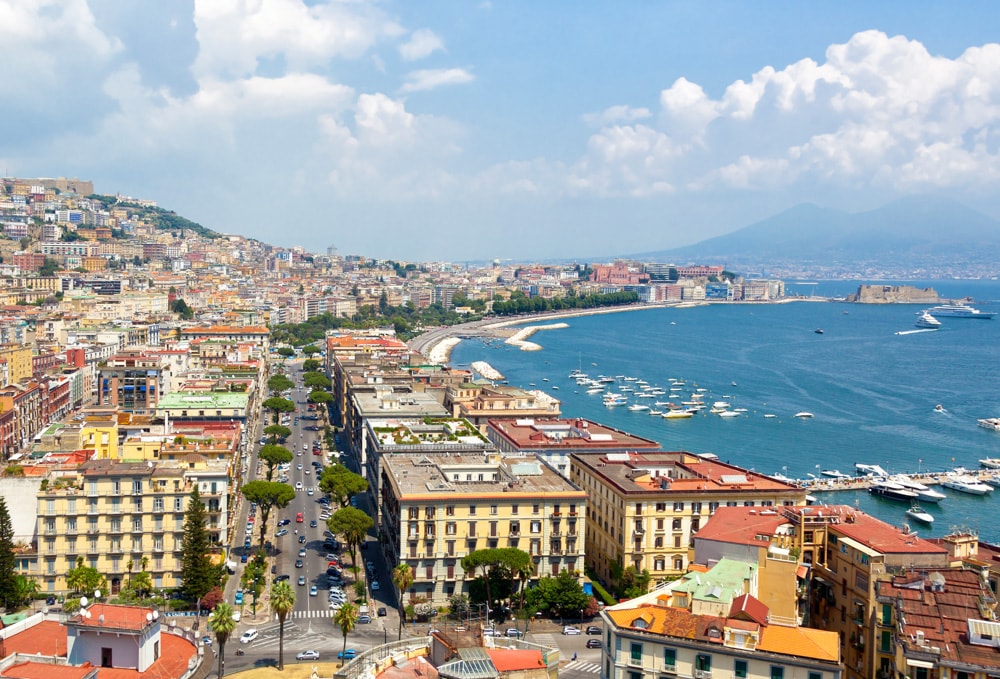
While there are countless historic sites to explore and things to do for foodies in Naples, don’t miss these places that make the city a must-visit.
Consider a walking tour to get an overview of the historic center (and some recommendations for pizza!). This well-reviewed tour lasts about 2.5 hours and covers major sights, including the famous Veiled Christ. Book this tour now!
First, if you’re looking for the food, Naples is the birthplace of pizza! All the flavors of Campania can be found in this food, so order a pie (not a slice) and dig in.
Next, the Galleria Umberto is a must-see. The stunning indoor shopping mall is nearly identical to the Galleria Emanuele in Milan, as it was designed by the same architect.
While most visitors to Naples come to see Pompeii, don’t miss the Naples Archeological Museum — it contains the largest collection of artifacts from Pompeii in Campania.
Finally, the Museo Sansevario is a gem of a small museum tucked away in a quiet neighborhood. It houses one of the world’s most beautiful statues, the Veiled Christ, carved from a single piece of marble.
Getting to Naples from Rome
The best way to get to Naples from Rome is by train. The high-speed train, at one hour and 10 minutes each way, is quick and easy, and you can be back in Rome in time for dinner.
Suggested by Lori of Italy Foodies
Viterbo
With one of the largest medieval historic centers in Italy, Viterbo is one of the most fascinating day trips from Rome you can do. Whether you are a history buff or a lover of art and architecture, you will enjoy your visit to Viterbo.
Viterbo was founded by the Etruscans, and it is famous for being a papal city in the 13th century.
The Palazzo dei Papi is one of the top sights in the city. The longest ever papal election (almost three years!) too place here between 1268 and 1271. The loggia is beautiful, and the Hall of the Conclave impressive.
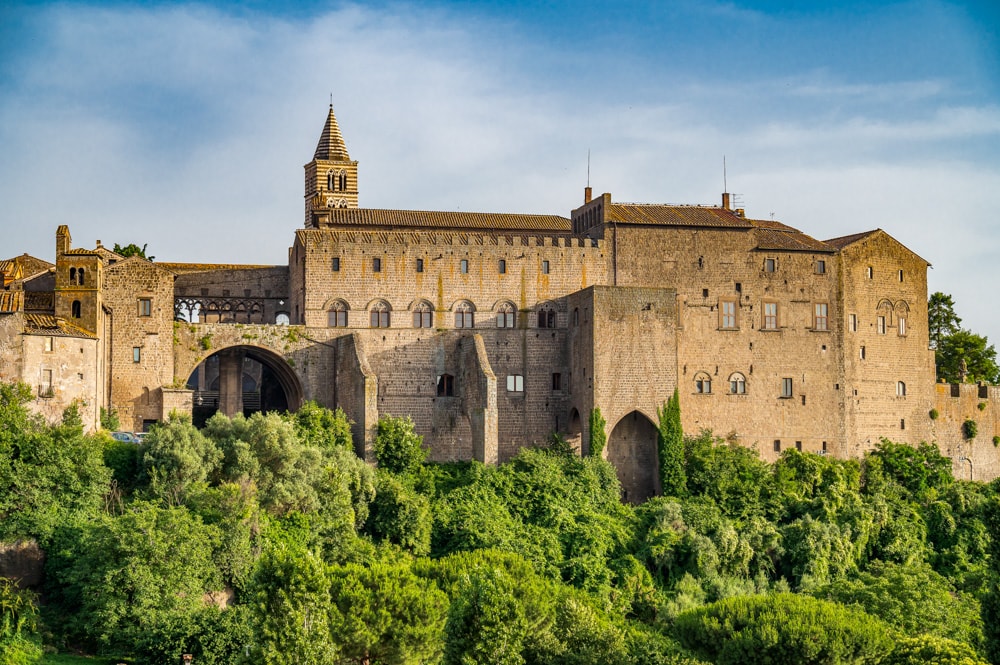
The Cathedral of Viterbo, dedicated to San Lorenzo, is the place where the popes elected in Viterbo were crowned. The Gothic bell tower is gorgeous. The cathedral has a Romanesque interior and a Renaissance facade.
The Colle del Duomo Museum contains sacred objects belonging to popes, cardinals, and bishops, as well as finds from Etruscan times and art works that include the Crucifixion of Viterbo, attributed to Michelangelo.
Tour the San Pellegrino Quarter and the Pianoscarano district, worth wandering for the well-preserved medieval buildings and charm of the streets. Here you can also enjoy lunch and some wine.
The Palazzo dei Priori and the Monastero di Santa Rosa are other sights to visit in town. Just a few miles outside the town is Villa Lante, a gorgeous complex that includes twin buildings, landscaped gardens, and lots of fountains and water features.
Getting to Viterbo from Rome
To get to Viterbo Porta Romana station from Roma Termini, take the direct regional train, which takes about 2 hours each way.
Suggested by us
Assisi
The UNESCO classified village of Assisi should be your number one stop from Rome.
Aside from the sheer beauty, it packs a ton of culturally interesting activities to do, not to mention it is located in Umbria, the truffle capital of Italy! Be prepared to have truffle on everything, without it breaking the bank.
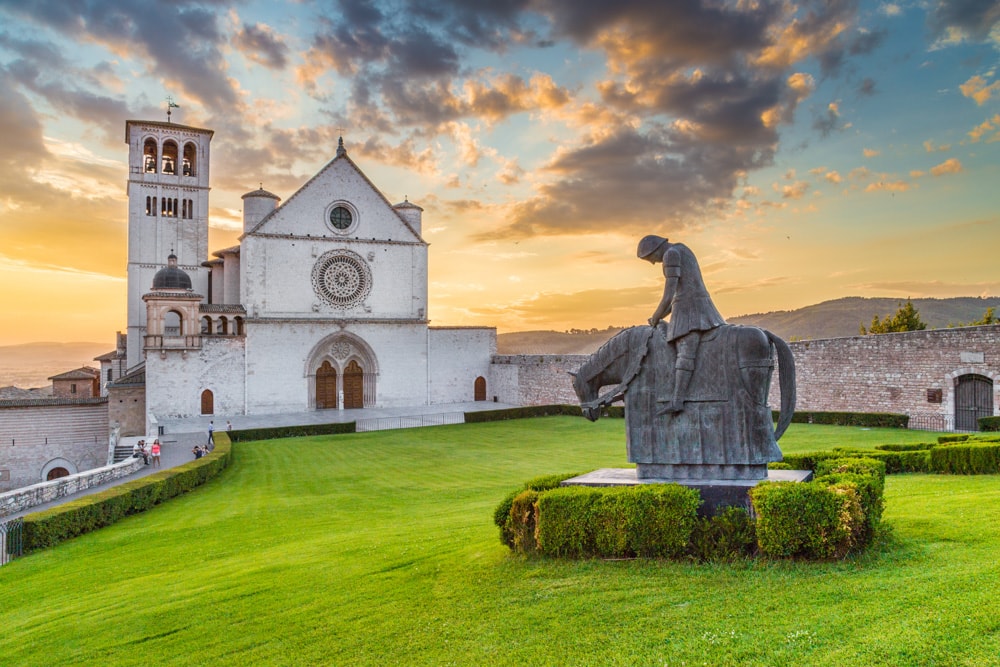
The town is best known as the birthplace of Saint Francis (of Assisi): you might know him as the founder of the Franciscan order. It will come as no surprise that Assisi holds many impressive pilgrimage sites dedicated to Saint Francis.
The most impressive sight in Assisi is the Basilica di San Francesco, unassuming from the outside, impossibly ornate inside.
The second Basilica to add to your list is that of St. Mary of the Angels, located on the outskirts of Assisi. The adventurous traveler can walk (it is about 4.4 miles from Assisi), though perhaps renting a bicycle and cycling the path might be more time-efficient.
Aside from basilica hunting, spend time languorously walking through the little streets of Assisi. Stop for a delicious gelato on the Piazza Commune, the best spot for some prime people-watching.
Getting to Assisi from Rome
Getting to Assisi from Rome is possible via public transportation, with direct trains running between Roma Termini or Tiburtina and Assisi Station. The fastest trains take just about 2 hours.
Renting a car is also an option to cover the 108-mile journey.
Prefer a guided tour? This well-reviewed tour combines Assisi with Orvieto for a full day out from Rome. Both Orvieto and Assisi are very picturesque hill towns and this tour offers a hassle-free way to visit them if you do not have a car and your time is limited.
Book this tour now!
Suggested by Caroline from Veggie Wayfarer
Tarquinia
One of the best day trips from Rome is to the small town of Tarquinia that is home to a unique UNESCO World Heritage Site called the Monterozzi.
Monterozzi is an Etruscan Necropolis that is home to 6,000 underground graves, which date back to 3rd century B.C. and earlier.
Two hundred of these tombs still retain vibrant frescoes that depict the life and culture of the people of the Etruscan Civilization that predates the Romans.
One of the best things to do in Tarquinia is to visit the Tomb of the Leopards. It is best known for its mural of two leopards painted over a banquet scene.
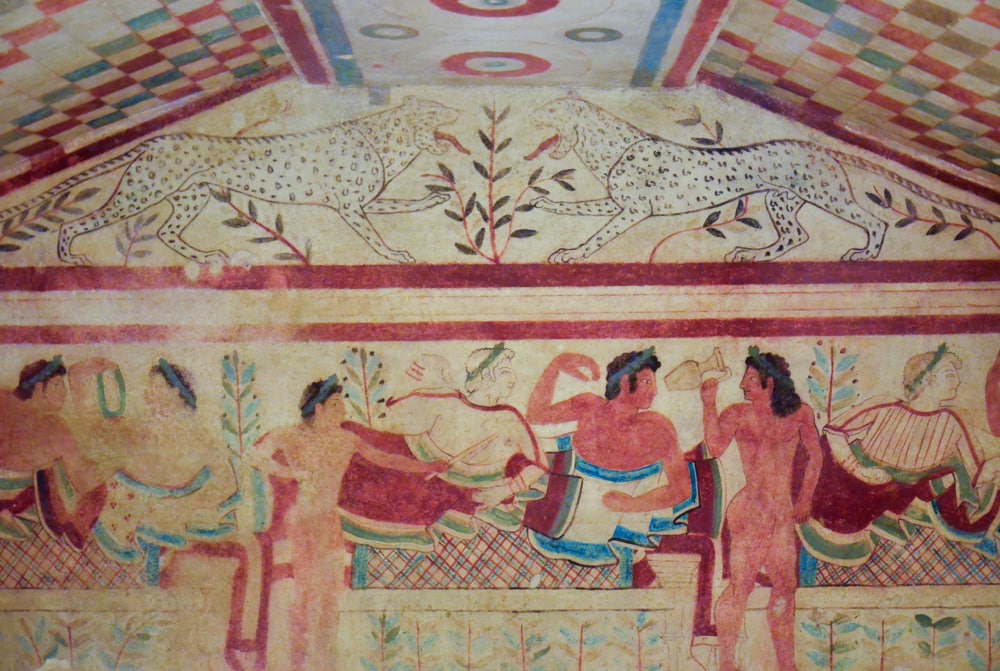
Other highlights include the Tomb of Hunting and Fishing, Tomb of the Triclinium, and the Tomb of the Augurs.
Be sure to visit the Tarquinia National Museum, a treasure trove of several Etruscan artifacts, restored fresco panels, and original sarcophagi.
The archaeological site and museum are open all days of the week except Mondays. A good time to visit is during spring or fall when temperatures are milder than summer.
Getting to Tarquinia from Rome
You can visit the necropolis in Tarquinia as an easy day trip from Rome. Get on a train bound for Pisa Centrale from Roma Termini and get off at Tarquinia. The ride takes about 1.5 hours.
Suggested by Soumya of Stories by Soumya
Sperlonga
Looking for a beach town to escape the city for a day? Consider the pretty town of Sperlonga! From spring through early fall, Sperlonga is one of the nicest day trips from Rome you can do.
There isn’t a long list of things to see and do in Sperlonga: it’s just a picturesque getaway with a relaxed ambience and beautiful views, perfect for a day of respite from hectic sightseeing.
The town is located on a bluff overlooking the sea. Walk uphill to the town center and spend some time wandering the charming little streets, lined with whitewashed houses. You’ll find lots of pretty photo spots as you stroll.
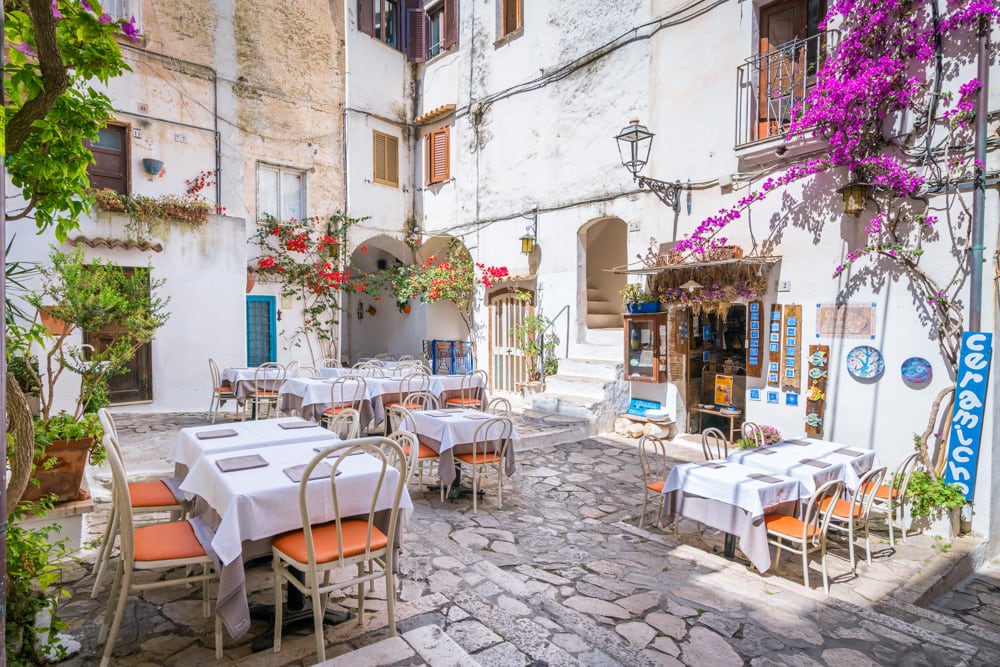
Browse the artisan shops and boutiques, and enjoy regional cuisine in the many eateries.
At the bottom of the bluff are the beaches, beautiful stretches of golden sand that look captivating against the turquoise of the sea.
Much of the beachfront belongs to hotels and beach clubs, so you’ll have to pay for the use of loungers and umbrellas, but you can also find free access areas.
Don’t miss the ruins of the Villa of Tiberius, just outside town. Also tour the archaeological museum, which holds some of the statues and other artifacts discovered at the site of the villa. And the grotto outside is stunning!
Torre Truglia, an old watchtower, is located on a small knoll by the water, directly below the town center. While the architecture of Torre Truglia looks a bit out of place, the views from the top are spectacular.
Getting to Sperlonga from Rome
Take the train from Rome to Fondi-Sperlonga, from where you can take a taxi or local bus to Sperlonga. The train journey takes about one hour and 15 minutes each way, and the bus takes about 40 minutes each way.
Suggested by us
Day Trips from Rome Over 2 Hours Away
The Amalfi Coast
Italy’s Amalfi Coast is one of the most beautiful stretches of coastline on the planet. Doing the Amalfi Coast drive is on the bucket list of many visitors to Italy, and deservedly so.
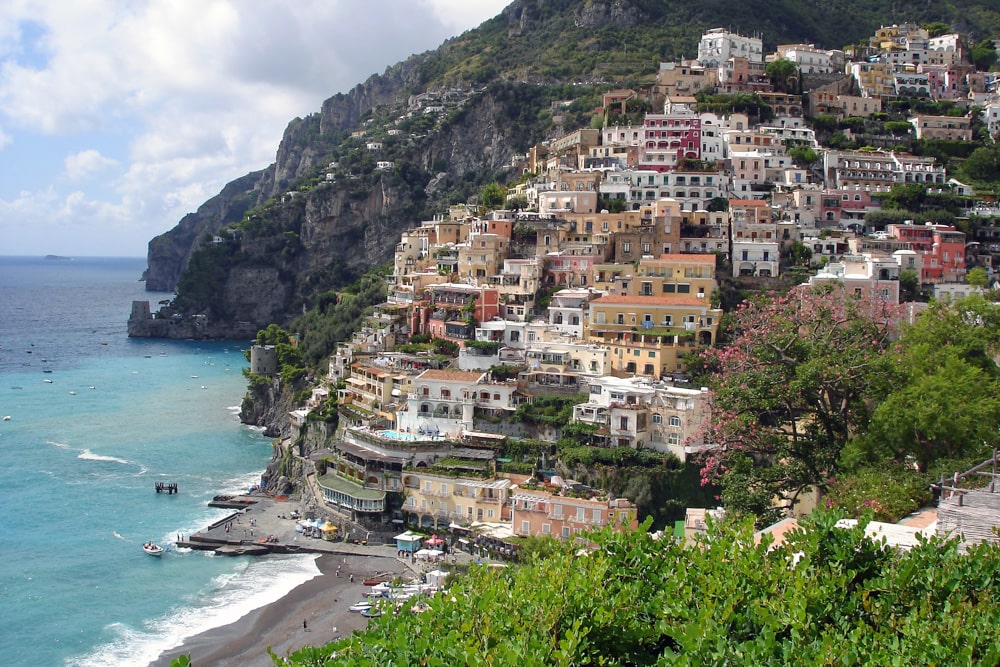
It’s a long day out from Rome, but the Amalfi Coast is so beautiful that if a day is all you have to spare, you’ll want to include this trip in your itinerary.
The string of beautiful little villages along the coast are all worth visiting, but the three most popular towns tend to be Positano, Amalfi, and Ravello.
You’ve probably seen numerous photos of Positano online: the cascading pastel-colored houses, the charming little alleys, the pebbly Spiaggia Grande, and the many boats on the impossibly blue Tyrrhenian Sea on a clear day.
Amalfi’s duomo has a glittering facade, and the alleys of the town are well worth the wander. Walk out onto the pier that juts out, to snap photos of the village from over the water.
Ravello is possibly our favorite Amalfi Coast destination. It’s perched high above the water, and getting there requires a little detour from the coastal road, but once you see charming Ravello and take in the views, you’ll agree the effort is worth it.
Getting to the Amalfi Coast from Rome
It’s a long day out from Rome, and the coastal road is not an easy drive. We recommend a guided tour if you plan to visit the Amalfi Coast on a day trip from Rome.
This very popular tour that combines a guided tour of Pompeii with a trip to the Amalfi Coast takes you to the sites by air-conditioned bus. You will have time to explore pretty Positano, and enjoy the superbly scenic drive along the coast.
Book this tour now!
Or check out this boat-hopping on the Amalfi Coast tour! The full day tour from Rome combines three ferry rides for a unique look at the stunning coastline from the sea. You will get to explore Positano and Amalfi and stop at a lemon grove for a limoncello tasting.
Civita di Bagnoregio
The fairytale town of Civita di Bagnoregio is a perfect place for a day trip from Rome. Known as the “Dying City,” its name actually means “Town of the Royal Baths” and upon visiting you will see it is actually very much alive!
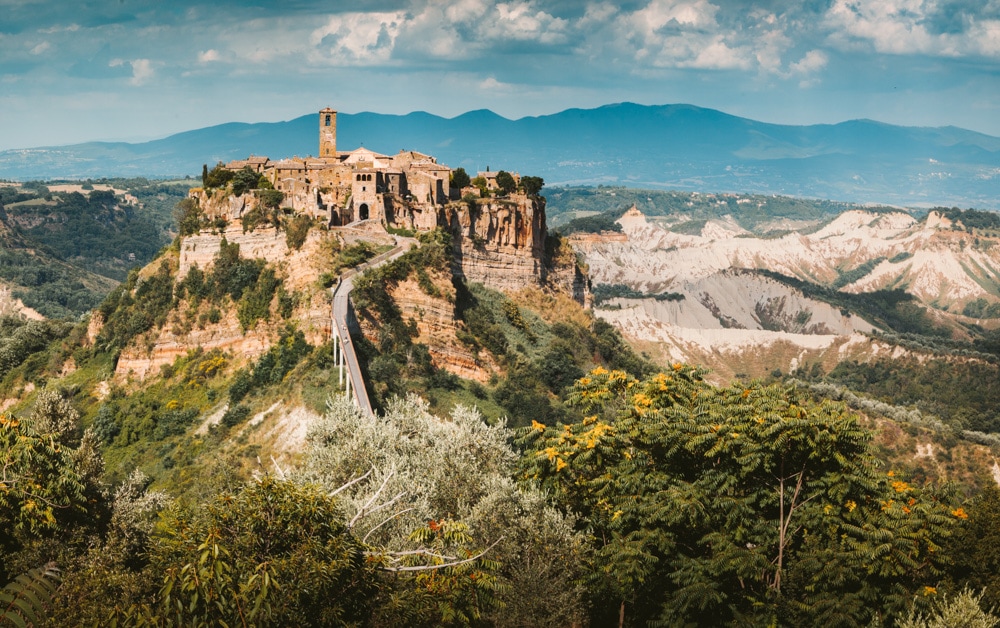
Upon getting to Bagnoregio – the modern part of town – walk towards the footbridge that will take you to the old city. The views from the Belvedere terrace overlooking the city are stunning: it looks like Civita di Bagnoregio is almost suspended on a rocky hill.
Once you cross the bridge, give yourself plenty of time to explore the city and take in its quaint atmosphere.
Your first sight will be the Porta di Santa Maria, one of the access gates into the walled city. Next, plan to spot the many palaces. The most beautiful one is Palazzo Alemanni, currently home to the Geological and Landslides Museum (an apt name for a museum in a city that is slowly deteriorating for geological reasons!).
Other notable palaces are the Palazzo Vescovile (Bishop Palace) and Palazzo Colesanti. The latter is located in the square where you’ll also find the Church of San Donato, originally a Romanesque Church that saw many modifications and is now predominantly Renaissance. Make sure to peep inside to find a fresco by Perugino!
Civita di Bagnoregio can be visited year round, but for a better experience try to go in early spring or fall (best in October). You’ll find it less crowded at these times. If you want to avoid the crowds, it’s also best to avoid visiting at the weekend.
Getting to Civita di Bagnoregio from Rome
Civita di Bagnoregio is located about 75 miles from Rome. There are no direct buses going there from Rome, so your best option would be to rent a car for the day (you’ll have to park it outside the old city).
You can also join one of the many guided tours that visit daily: this guided tour combines Civita di Bagnoregio with Orvieto for a fabulous day trip from Rome by coach.
Book this tour now!
Suggested by Claudia of Strictly Rome
Pompeii
The Pompeii archeological site is one of the most popular tourist destinations in Italy. The views of Vesuvius and walking the archeological site make for a nice break from the hustle and bustle of Rome!
Located near Naples, at the foot of Mount Vesuvius, Pompeii is an ancient Roman city that was destroyed by a volcanic eruption in 79 AD. It is a must-visit for visitors that want to learn more about the history of the Roman Empire.

The archaeological site is very well preserved and it offers a fascinating glimpse into the life of the ancient Romans. Visitors to Pompeii can explore these ruins and imagine what life was like in this ancient city.
There are many interesting ruins, including the forum, where public events and markets took place, as well as many different shops that have been preserved.
There are also several homes that have been remarkably well-preserved since they were buried beneath ash and lava when Mount Vesuvius erupted.
Don’t miss the Teatro Grande, built to seat about 5,000 spectators, the beautiful Temple of Isis, the Terme Stabiane, the best-preserved baths in Pompeii, and the amphitheater, which could accommodate 12,000 spectators.
The best time of the year to visit Pompeii is during the off-season, between November and March, since the summer season is busy. It is also much cooler to wander around the site in the winter months.
Getting to Pompeii from Rome
Pompeii is a popular destination and is worth visiting as part of your Rome itinerary.
To visit Pompeii from Rome, take the direct high-speed train to Naples, which takes about one hour and 15 minutes each way. From Naples, take the Circumvesuviana train or a regional train to Pompeii.
Pompeii is a large and complex archaeological site, and a guided tour makes a lot of sense, to ensure you see everything of import in an efficient manner, and learn as you explore.
This highly-rated tour combines a fully-guided tour of the digs at Pompeii with either a hike on Mount Vesuvius (in the summer) or Naples (in the winter). The full day tour lasts about 13 hours.
Suggested by Mayuri from To Some Place New
Herculaneum
Herculaneum, an ancient town in the region of Campania, was buried in the eruption of Mount Vesuvius in AD 79. A popular resort for the nobility of Rome, Herculaneum was a prosperous town.
A smaller archaeological site when compared to the more famous Pompeii, Herculaneum makes for a fascinating day trip from Rome. With Pompeii and Torre Annunziata, Herculaneum is designated a UNESCO World Heritage Site.
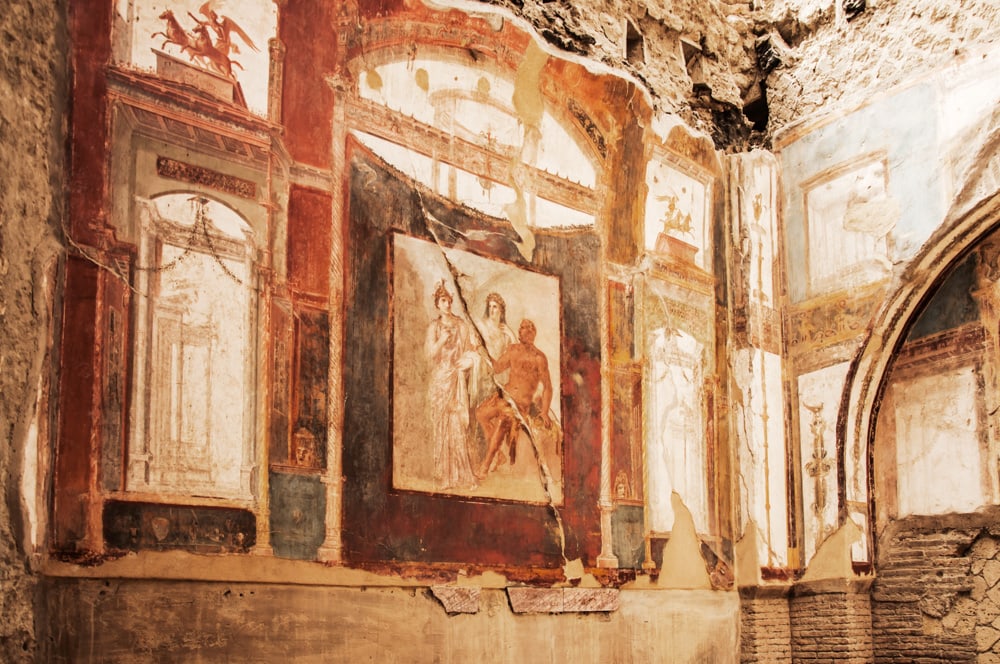
Instantly buried under several dozen feet of ash, Herculaneum is better preserved than Pompeii, with parts of two-story homes intact, complete with furnishings and even food.
There are many significant structures you must not miss when you tour Herculaneum. The Men’s Baths, part of the Central Baths, feature changing rooms, as well as three bathing areas, one of which has a beautiful mosaic of Triton.
The Hall of the Augustals has two gorgeous frescoes, both of Hercules, the Greek god after whom the town was named. The House of the Samnites has a stunning atrium with painted walls.
In the House of the Wooden Partition, you’ll still find the namesake wood partition, which is still standing at its original location! The House of Relief of Telephus was a three-story home decorated with sculptures.
Since Herculaneum is a smaller site, you can even combine a tour of the site with a visit to the top of Mount Vesuvius. Vesuvio Express buses take you from the train station at Ercolano to the parking lot at the top of the crater.
Getting to Ercolano from Rome
To visit Herculaneum from Rome, take the direct high-speed train to Naples, which takes about one hour and 15 minutes each way. From Naples, take the Circumvesuviana train to Ercolano Scavi.
From the train station in Ercolano, it’s a 10-minute walk to the entrance to the ruins.
Suggested by us
Sorrento
Sorrento is an incredible day trip to add to your Rome itinerary. From views of Mt. Vesuvius to beach clubs and lemon groves, the town has plenty to enjoy!
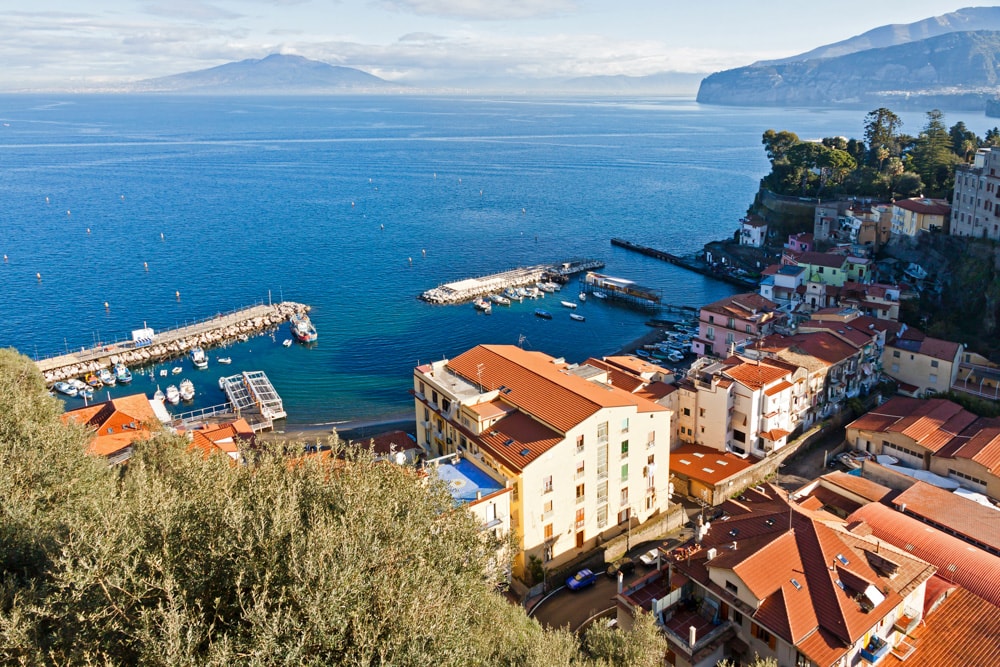
Sorrento is bustling with shops and restaurants dotted along the alleys and perfect for really beautiful souvenirs.
When visiting Sorrento, hanging out at one of the beach clubs is a must. Sorrento has crystal clear water and colorful beach clubs. Although there is little to no sand, the decks provide a great area for sunbathing and enjoying the water.
Another really popular activity in Sorrento is visiting a lemon grove. Sorrento is known for its giant lemons. Usually, when you visit, they are very generous in giving you lots of limoncellos! A fun grove to visit is I Giardini di Cataldo.
You also won’t want to miss strolling down Sorrento’s main shopping street, Corso Italia. Here you will find many of the main shops and restaurants, including gelato at Gelateria Primavera.
Additionally, you can stroll through Marina Grande, the fishing village. The area is also very beautiful, especially during the spring and summer. You will find another beach that is very popular among locals.
The best time to visit Sorrento is during the spring and summer. During these times you will have great weather to enjoy the beaches.
During the spring you will still be in shoulder season with fewer crowds. Summer is the most popular time to visit, but it is also the best beach weather.
Getting to Sorrento from Rome
It is pretty easy to get to Sorrento from Rome. Take the fast train from Roma Termini to Naples. From Naples, you can either hire a private car to drive you to Sorrento or take the Circumvesuviana train, which takes a little bit longer than a private car, but is still easy.
Suggested by Sam of Find Love & Travel
Pisa
A day trip to Pisa in Tuscany is one of the most beautiful day trips from Rome you can take.
Pisa is probably best known for its Leaning Tower, one of Italy’s most recognizable landmarks. The sinking tower is the bell tower of the beautiful Pisa Cathedral, and provides fabulous views from the viewing area at the top.
Pisa Cathedral, the tower, baptistery, and cemetery stand on the gorgeous Square of Miracles. The Miracles Square with the four monuments is a UNESCO World Heritage site and a must-see in Tuscany, Italy.
Pisa is built along the famous River Arno, and enjoying the extraordinary landscapes along the river is one of the best things to do in Pisa.
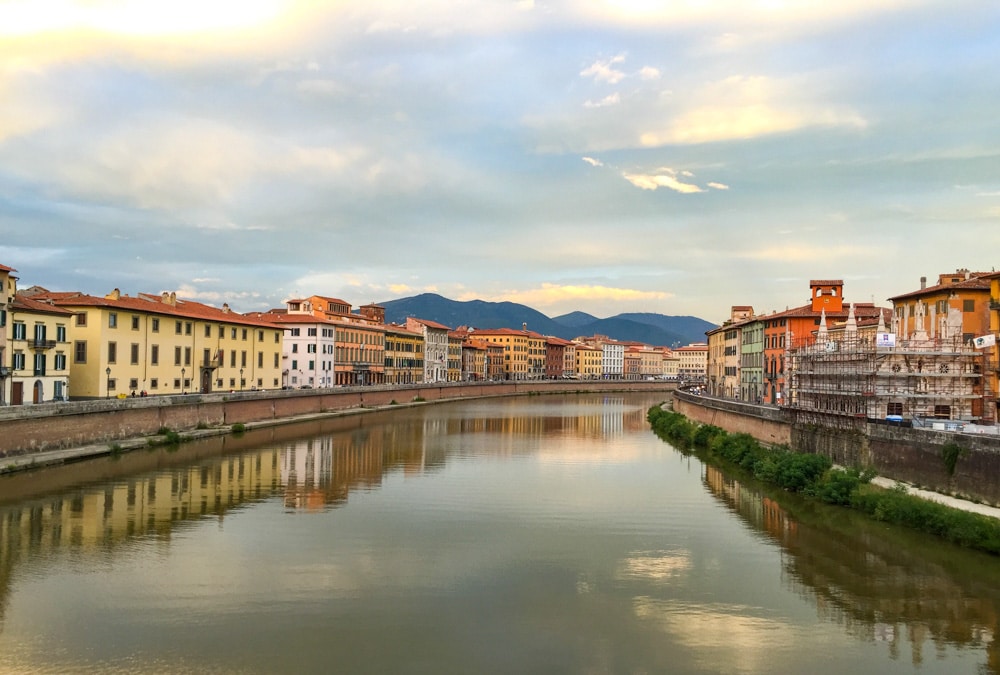
The Knights Square (Piazza dei Cavalieri in Italian), between the Arno and Miracle Square, is the main square of Pisa. Make a stop at this historic square, and observe the intricate facades of the surrounding historical buildings.
Don’t forget to visit the Pisa Botanical Garden, one of the first botanical gardens in Europe. Today it belongs to the University of Pisa, and contains plantings, ponds, and greenhouses you can tour.
The best time to visit Pisa is from May to October. June or September is ideal, to escape the summer heat and tourist crowds.
Getting to Pisa from Rome
Pisa is easily reachable from Rome by high-speed train, which takes 2.5 hours each way. The direct train goes from Roma Termini to Pisa Centrale.
Suggested by Milijana of World Travel Connector
Val d’Orcia in Tuscany
For a little taste of Tuscany on a day trip from Rome, consider the beautiful region of Val d’Orcia, where you can visit the hilltop towns of Montalcino, Pienza, and Montepulciano.
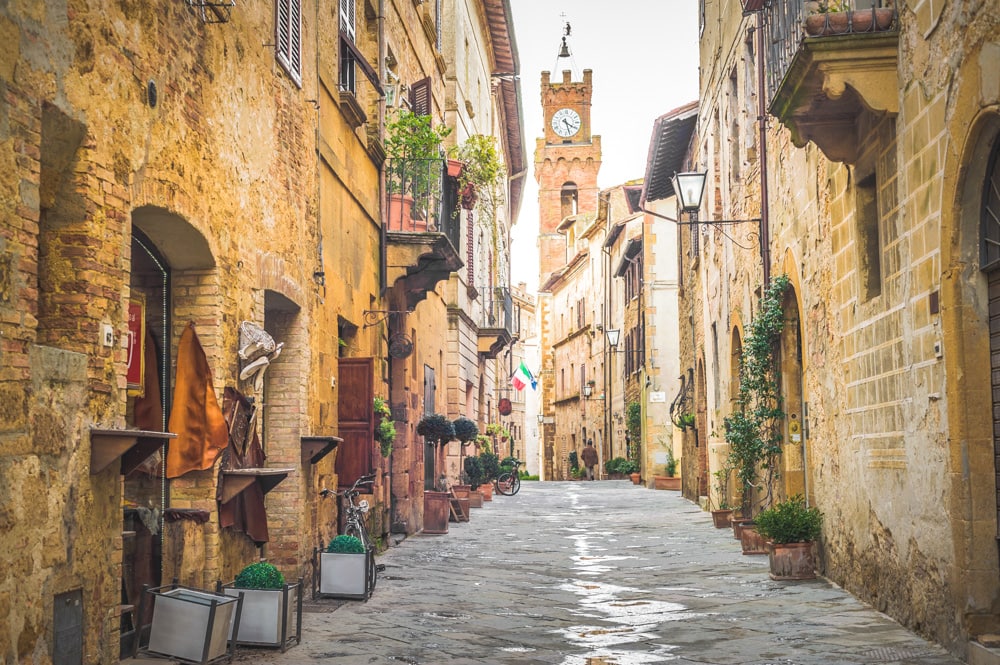
Rolling hills. Rows of stately cypresses. Olive groves. Picturesque farms dotting the hillsides. Historic abbeys. The Val d’Orcia is picture postcard Tuscany, and a UNESCO World Heritage Site.
Montalcino is famous for its Brunello red wine, made from local Sangiovese grapes. Perched on a hilltop, the town affords spectacular views of the surrounding countryside. In town visit the impressive fortress and wander the little streets and alleys.
Pienza, the “ideal Renaissance town,” is famous for its architecture. The Palazzo Piccolomini, the town hall, and the main square, Piazza Pio II, are all beautiful. Pienza is also known for pecorino cheese.
Montepulciano, technically not in the Val d’Orcia, is another must-visit town nearby. It is home to the famous Vino Nobile. Start at the Piazza Grande and walk through the town to savor its charm. Take in the panoramic views of surrounding hillsides and vineyards.
If you enjoy wine tastings, there are several wineries you can visit outside Montalcino and Montepulciano. Many of these wineries offer food as well.
Getting to the Val d’Orcia from Rome
If you plan to visit independently, we recommend renting a car for the day. At each town, you can park just outside the entrance to the historic center, and then explore on foot.
This highly-rated tour of the Tuscan countryside from Rome includes lunch at a farm, wine tasting, and a visit to an abbey. Explore the wine towns of Montepulciano and Montalcino, and wander Pienza, designated a UNESCO World Heritage Site.
Check pricing and availability for this Val d’Orcia tour now!
Suggested by us
Bologna
For lovers of history and architecture, and for foodies, Bologna is a must-visit destination in Italy. Although you can spend much longer than one day exploring and eating your way through Bologna, you can also have fun on a day trip to the city.
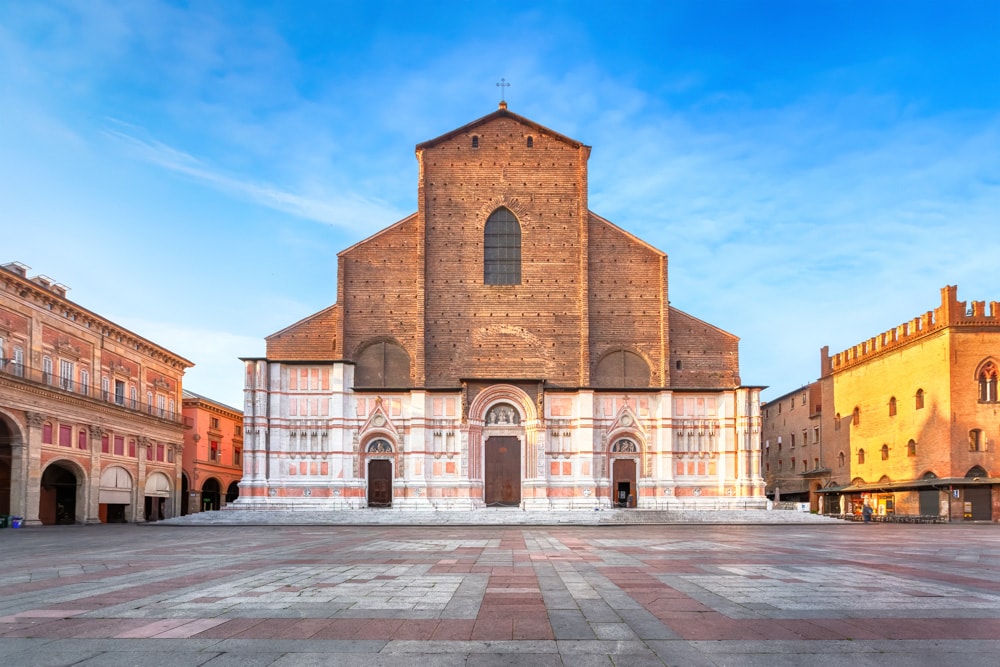
In Bologna’s historic center, you’ll love walking the many porticoes. The porticoes of Bologna are a UNESCO World Heritage Site, and they make for beautiful photos!
Start by visiting Piazza Maggiore, the main square, lined with beautiful buildings. One entire side of the square is taken up by the massive Basilica of San Petronio. In the nearby Piazza del Nettuno, admire the Fountain of Neptune.
Bologna is home to not one but two leaning towers! If you’re up for the challenge, climb the 498 steps to the top of the Asinelli Tower for magnificent views over Bologna.
Walk through the Quadrilatero, the historic Bologna market, which has been functioning as a commercial center since medieval times. You’ll find fish, produce, and fruit here, but also a variety of other stores and eateries.
When in Bologna, you have to eat! Some of the foods to try here include cured meats such as mortadella and prosciutto, parmigiano reggiano, and pasta dishes like tagliatelle al ragu and tortellini en brodo.
Taking a food tour is a great way to sample some of the famous foods of the Emilia-Romagna region. You’ll also learn about the city as you walk.
Getting to Bologna from Rome
To get to Bologna from Rome using public transport, take the fast train. The journey is 2 hours and 20 minutes each way.
Suggested by us
Train Travel in Italy
The train is a comfortable and very convenient mode of transport in Italy, and sometimes more efficient than driving, because it saves you the hassles of finding parking. It’s also eco-friendly.
For day trips, when you don’t have luggage, trains are a no-brainer. We’ve done numerous day trips by train in Italy and it’s our first choice for inter-city or regional travel.
You’ll find both high-speed and regional trains in Italy. High-speed trains usually connect larger cities and tend to be more expensive. Regional trains cover smaller cities, towns, and villages, and they are slower but cheaper.
Trenitalia is the state-owned company that offers both high-speed and regional train transport in Italy. Italo, a private company, offers high-speed services on certain routes.
High-speed train tickets tend to increase in price as your travel date gets closer, and it makes sense to book them in advance, as soon as your plans are crystallized.
To book train and bus tickets for Europe travel, including Italy, check out Omio. The website is in English and easy to navigate, and we’ve not had any problems booking tickets using our US credit cards.
Check availability and prices for your Italy train tickets now!
Regional train tickets can be purchased on the day of travel on most routes. Remember to validate your regional train tickets at the machines in the station prior to boarding your train to avoid hefty fines.
Buy your return tickets at the same time as you buy tickets to your day trip destination. It will save you time later in the day, plus in some small places, you may not even find a ticket window or machine!
*****
If you enjoy day trips as a means to exploring out from big cities, check out our other day trip guides for Italy!
- Day Trips from Venice
- The Best Day Trips from Sorrento
- Must-Do Day Trips from Florence
- Day Trips from Bologna by Train
- The Best Day Trips from Milan
Did you find this article informative? Pin it for later reference!
